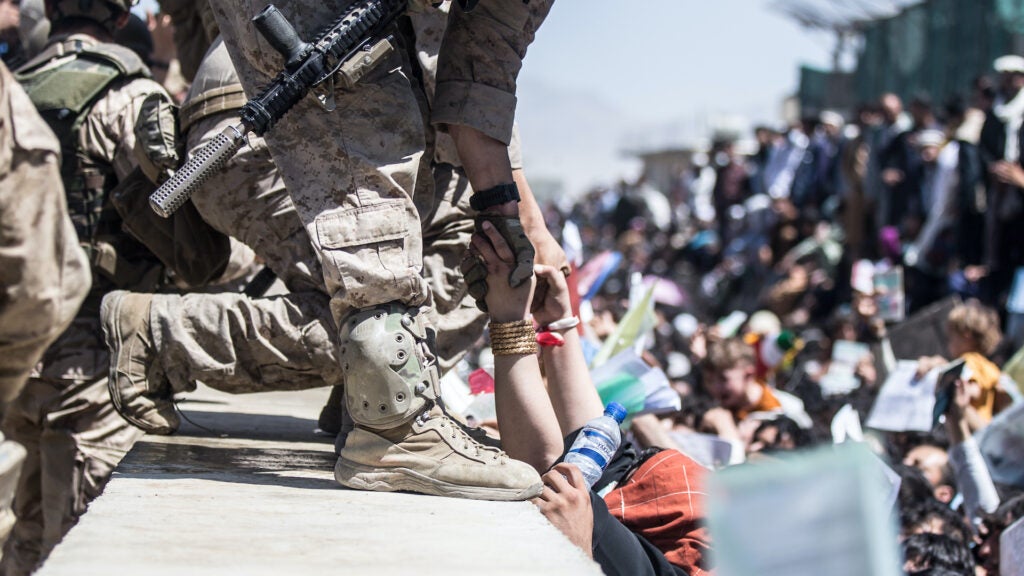Terrorists are continuing to try to kill U.S. troops at Kabul’s international airport in the final hours of the Afghanistan evacuation.
Five rockets were fired at Hamid Karzai International Airport on Monday, Navy Capt. Bill Urban, a spokesman for U.S. Central Command, told the Associated Press. No American casualties were reported.
A counter rocket, artillery, and mortar system (C-RAM) at the airport reportedly engaged the rockets, according to the Associated Press. It was not immediately clear if any of the projectiles were intercepted.
The Islamic State group in Afghanistan has claimed responsibility for the rocket attack, which highlights just how perilous the security situation at Hamid Karzai International Airport is as the last U.S. troops prepare to leave by the end of Tuesday.

Meanwhile, Task & Purpose continues to hear from sources that the Taliban are not allowing American citizens and Afghans with proper credentials to make it into the airport for evacuation flights, leaving them potentially stranded in Kabul.
The U.S. military’s focus now is on evacuating the people already at the airport, BBC World Service correspondent Nafiseh Kohnavard tweeted on Monday. American troops guarding the airport will eventually be replaced by “Taliban Special Forces.”
“Serious concerns about the moment that thousands of people outside Kabul airport will realise the US guards have left the airport premier as they may storm the runaway,” Kohnavard tweeted.
And there are no indications that the ISIS threat has abated at all.

Monday marked the second time in the past five days that Kabul’s airport has come under attack. A suicide bomber struck outside the airport’s Abbey Gate on Aug. 26, killing 11 U.S. Marines, a Navy corpsman, and an Army special operations soldier and wounded another 18 U.S. troops were wounded in the attack.
The Islamic State-Khorasan, or ISIS-K, claimed responsibility for the attack, which killed more than 170 Afghan civilians. Marine Gen. Kenneth McKenzie Jr., head of CENTCOM, told reporters on Aug. 26 that ISIS attacks against U.S. troops at the airport would likely continue.
President Joe Biden announced on Aug. 26 that he had ordered military commanders to “develop operational plans to strike ISIS-K assets, leadership, and facilities.”
The following day, the U.S. military announced that it had launched a drone strike against an “ISIS-K planner” in Afghanistan’s Nangarhar province, reportedly using the R9X variant of the Hellfire missile, which has been dubbed the “flying Ginsu” and “ninja bomb” because it uses flying blades rather than explosives as the killing mechanism to reduce civilian casualties.

Two “high profile ISIS targets” were killed in the strike and another one was wounded in the strike, Maj. Gen. William “Hank” Taylor, deputy director for regional operations for the Joint Staff, told reporters at an Aug. 28 Pentagon news conference. It was unclear if they had any role in the suicide bomber attack on Kabul’s international airport.
“The situation on the ground continues to be extremely dangerous, and the threat of terrorist attacks on the airport remains high,” Biden said in an Aug. 28 statement. “Our commanders informed me that an attack is highly likely in the next 24-36 hours.”
Then, on Aug. 29, the U.S. military launched another strike, this time against a vehicle in Kabul to prevent “an imminent ISIS-K threat to Hamid Karzai International airport,” according to Urban.
Urban initially said there were no indications that any Afghan civilians were killed as a result of the attack, but he issued another statement several hours later acknowledging that CENTCOM was aware of reports of civilian casualties.
“We know that there were substantial and powerful subsequent explosions resulting from the destruction of the vehicle, indicating a large amount of explosive material inside that may have caused additional casualties,” Urban said. “It is unclear what may have happened, and we are investigating further. We would be deeply saddened by any potential loss of innocent life.”
More great stories on Task & Purpose
Want to write for Task & Purpose? Learn more here and be sure to check out more great stories on our homepage.
